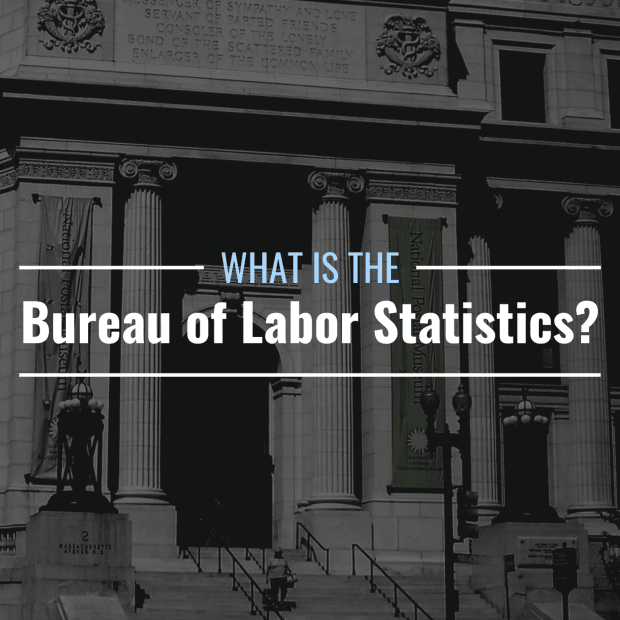
AgnosticPreachersKid, CC-BY-SA-3.0 via Wikimedia Commons; Canva
What Is the Bureau of Labor Statistics? What Does It Do?
The Bureau of Labor Statistics, or BLS, is a federal agency that collects and disseminates information about labor, wages, productivity, and prices on behalf of the U.S. government. Its parent organization is the U.S. Department of Labor.
The BLS bills itself as the “principal fact-finding agency for the Federal Government in the broad field of labor economics and statistics,” and according to USA.gov, its purpose is to measure “labor market activity, working conditions, and price changes in the economy.”
It is responsible for releasing the monthly consumer and producer price indexes—the two most commonly used benchmarks for measuring inflation—as well as the monthly Employment Situation Report, which includes the widely followed unemployment rate, a major indicator of the country’s economic health.
The information that the BLS surveys, compiles, and releases is crucial to the decisions of investors, policymakers, and even the Federal Reserve. In fact, the Fed looks specifically at the two price indexes and employment data released by the bureau when deciding whether to raise, lower, or maintain the federal funds rate. This is the interest rate range for inter-bank loans, and it is considered the “one rate to rule them all,” in that it informs everything from bond prices to consumer and business loan rates to foreign exchange rates.
Important Reports Released by the BLS
The BLS releases a variety of reports on monthly, quarterly, and annual bases. Some of these reports include data from one particular survey, while others include data from two or more surveys conducted by the bureau. The three most important reports released by the bureau are the Consumer Price Index, the Producer Price Index, and the Employment Situation Report.
Consumer Price Index (CPI)
The Consumer Price Index is essentially a weighted average aggregate of the prices of common consumer goods and services in the United States. Sample categories include food and beverages, housing, apparel, transportation, medical care, recreation, education and communication, and other goods and services.
Changes in CPI over time are used by analysts, economists, and the Fed to estimate the rate of inflation for consumer-facing goods and services.
Producer Price Index (PPI)
The Producer Price Index is an estimate of the average value of all first-stage domestic products and services for a given month. It is very similar to the CPI, but instead of sampling and averaging prices for consumer-facing products and services, it samples and averages prices of first-stage products and services—those sold by producers (usually to other businesses).
Changes in CPI over time are used by analysts, economists, and the Fed to estimate the rate of inflation for business-facing or supply-side goods and services.
Employment Situation Report
The Employment Situation Report, also known as the Jobs Report, includes information about employment, unemployment, hours worked, and wages both in general and broken down by region, race, and other demographics.
The data used to compile the report actually comes from two separate surveys that the BLS conducts on a monthly basis—the Current Employment Statistics Survey, which collects information from about 697,000 work sites, and the Current Population Survey, which is conducted with the help of the U.S. Census Bureau and samples around 60,000 households.
Along with the CPI, PPI, and GDP, the Fed analyses the unemployment rate, which is included in the Employment Situation Report, when making decisions about interest rates and bank reserve requirements in an effort to maintain a healthy economy.
Other Reports
- U.S. Import and Export Price Indices
- Consumer Expenditure Survey
- National Compensation Survey
- Employment Cost Index
- Workplace Injury and Fatality Statistics
- Labor Productivity Statistics
Where Is the BLS Headquartered? How Large Is It?
The Bureau of Labor Statistics is headquartered in the Postal Square Building in Washington, D.C. It shares the building with the National Postal Museum and the offices of the U.S. Senate.
The bureau also has six large regional offices spread around the country, bolstered by an array of smaller local offices across each region. In total, the bureau employs around 2,400 individuals nationwide.
How Does the Bureau Divide Its Statistics Geographically?
The BLS breaks up much of the data it collects into geographical subcategories so that area-specific insights can be gleaned from its reports. Data is divided into four general regions that span the country, and each of these is further divided into divisions and specific states as follows:
Northeast Region
- New England Division: Connecticut, Maine, Massachusetts, New Hampshire, Rhode Island, and Vermont
- Middle Atlantic Division: New Jersey, New York, and Pennsylvania
South Region
- South Atlantic Division: Delaware, District of Columbia, Florida, Georgia, Maryland, North Carolina, South Carolina, Virginia, and West Virginia
- East South Central Division: Alabama, Kentucky, Mississippi, and Tennessee
- West South Central Division: Arkansas, Louisiana, Oklahoma, and Texas
Midwest Region
- East North Central Division: Illinois, Indiana, Michigan, Ohio, and Wisconsin
- West North Central Division: Iowa, Kansas, Minnesota, Missouri, Nebraska, North Dakota, and South Dakota
West Region
- Mountain Division: Arizona, Colorado, Idaho, Montana, Nevada, New Mexico, Utah, and Wyoming
- Pacific Division: Alaska, California, Hawaii, Oregon, and Washington
When Was the BLS Created? Who Is in Charge of it?
The BLS was created in 1884 via the Bureau of Labor Act, and at that time, it was part of the Department of the Interior. By 1913, it was an arm of the Bureau of Labor, which is where it resides to this day.
Over the course of its existence, the bureau has been directed by a series of commissioners, each of whom serves a four-year term. The first Commissioner of Labor was Carroll D. Wright, and the current commissioner, as of August 2022, is William Beach.







